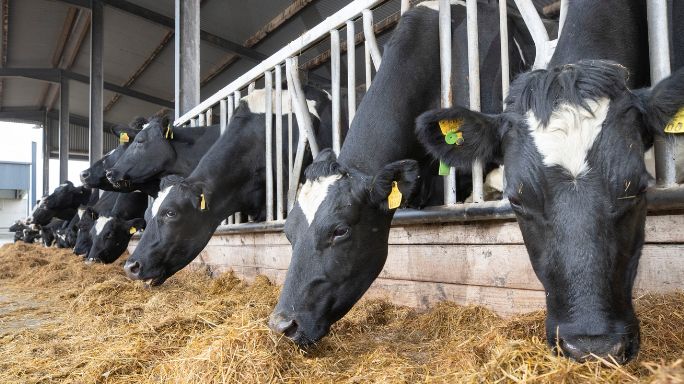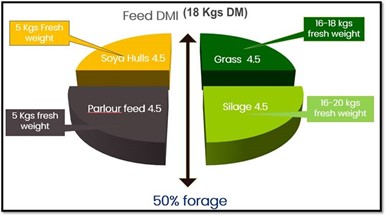Tips to navigate the current weather challenges

Drying conditions will be generally moderate or poor this week with the weather forecasted to remain unsettled with spells of rain meaning getting cows to grass may not be possible for some.
Given the current weather conditions and silage stocks running tight on the farm, what are the options to extend current silage stocks?
The first protocol is to assess opportunities to get animals out to grass by identifying the driest paddocks and utilising on/off grazing and spur roadways. Prioritise access to grass for longest-calved cows who are nearing peak milk production and keep fresh cows indoors in a separate group for 4-5 days.
However, for those that have already grazed off their driest paddocks leaving no option but to keep cows in until ground dries up, look to source additional fodder supplies if you anticipate to remain indoors for another period of time. The overarching consensus from the most recent National Fodder and Food Security Committee (NFFSC) was that supplies of fodder are available to purchase.
In situations where access to purchase fodder is limited or the quality is very poor, see below commonly used strategies to stretch fodder during fodder shortages or when the grass is not accessible.
How much silage will I save by increasing concentrate intake?
Feeding 1kg extra of concentrate will save approximately 4-5kg of fresh-weight silage depending on the dry matter of the silage. For example, feeding 100 cows an extra 2kgs each of concentrate will save 1000kg of silage or 1.25 bales per day.
Increasing parlour feeding
Cows can safely take in 8kg of concentrates in 2 feeds through the parlour/day, where a farmer is housed fully and is feeding to support milk and save on silage. This is the most common initial solution as it is the most convenient and least labour-intensive. Feeding additional concentrate through the parlour will most commonly see best performance when compared to other options as a dairy nut such as GAIN Spring Starter is nutritionally balanced to avoid digestive upsets and contains Bioplex® protected minerals which will be vitally important as we head for the breeding season.
Feeding straights
For herds that need to save more silage, a midday feed of a straight such as soya hulls will be the next best option. Soya hulls is a safe palatable feed that can be fed at high levels as it is high in fibre and energy. Maize meal and citrus pulp are also good options for midday feeds.
Often we see herds being fed 6-7kg of nuts in the parlour with a 3-4kg midday feed. Although this allows for a greater concentrate intake overall, it may not suit all farms given the extra workload and required head space for feeding. It’s also important to remember not to cut the nut in the parlour back too much as this can often be the cows only additional source of minerals.
The safe limit of concentrate intake will be approximately 50% of the cows overall dry matter intake (approximately 10kg fresh weight of concentrate). Always aim to keep forage as the remaining 50% of the intake to maintain rumen function and cow health.

Not all straights will be suitable as they can lead to a digestive upset. Feeds such as rolled wheat or barley when feed in addition to high concentrate levels will not be the most suitable here as they’re very high in rapidly digestible starch which may cause a digestive upset or scouring.
Feeding palm kernel at high levels is not always advisable, especially to cows that are not long calved, hitting peak or preparing for the breeding season. Palm kernel is not an appetising palatable feed, so it will be generally hunger that drives cows to take it any quantity of it. We would recommend that cows should not be fed more than 2-3kgs of palm kernel to avoid any digestive upsets. It may seem like a cheap option currently but caution must be advised before using.
Using beef feed
Using straights on farm at this time of the year will not be practical for many for various reasons. If a farmer has a beef feed such as GAIN Wean N Build, GAIN Stock Mix, GAIN Elite Beef etc, these can all be used as suitable midday feeds as they are all nutritionally balanced to allow for high feeding levels.
Water intake
Access to clean unrestricted amounts of water becomes all the more important when feeding high concentrate levels. Cows intake of water at these times will increase, therefore it is very important to check troughs regularly and ensure cows are not having to wait before drinking. Cows that have a restricted water intake will see an immediate decline in milk volume output.
Once the weather does improve, things can change quickly. On a positive note, there is plenty of grass on most farms with grass growth increasing.
If you require any further support, do not hesitate to contact your local Tirlán Representative or local advisor.
First Published: 04 April 2024
Tagged with: Beef Dairy Other animals
